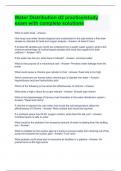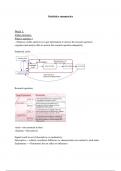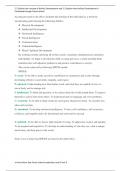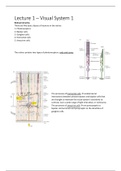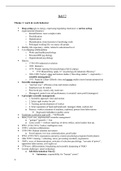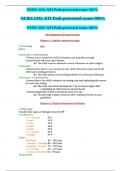Table of contents
Lecture 1
Introduction
Policy resistance
Dynamic complex systems (chapter 1)
Linear vs. feedback view
Characteristics of dynamic complex systems
Feedback loops
System behavior
System dynamics
The modeling process (chapter 3)
Different than other simulation models
Systems dynamics modeling
Lecture 2
Structure and behavior of dynamic systems (chapter 4)
Fundamental modes of dynamic behavior
Exponential growth (and exponential decline)
Goal seeking (exponential decay, i.e. half-life)
Oscillation
S-shaped growth
Growth & overshoot (S-shaped growth & overshoot)
Overshoot & collapse
Systems archetypes
Causal Loop Diagramming (CLD)
Elements of a CLD
Modeling problems
Lecture 3
Characteristics of stocks
Translating from CLD to stock & flow structure:
Auxiliary variables
Network of stocks & flows
Aggregation
Integrating flows
Integration
Differentiation
Analytical integration of a fluctuation
1ZM65 - course summary 1
, Accumulating stocks
Lecture 4
Quadratic versus cosine function
First-order positive feedback (exponential growth)
Analytical expression
Phase plot
First-order negative feedback (exponential decay)
Analytical expression
Phase plot
Explicit goals
First-order negative feedback (exponential decay) with explicit goal
Analytical expression
Phase plot
First-order differential equation
Nonlinear population system
Dynamic behavior (P/C)
Phase plot
Logistic growth model (first-order non-linear)
Analytical expression
Dynamic behavior (P/C)
Phase plot
Lecture 5
Logistic growth in Vensim
SI-model (Susceptible <> Infectious)
SIR Epidemic model (Susceptible, Infectious, Recovered)
Side-effect of the contact rate
Bass Diffusion Model
Extension: replacement products
Extension: complementary products
Misperception of feedback
Lecture 6
Basic delays
Pipeline delays (fixed delay)
Higher-order delays
Third-order delay example
General linear second-order model
Steady-state equilibrium
Second-order differential equations before equilibrium
General approach to second-order differential equations
General solution
Vensim example with damping
Lecture 7
Principles for modeling human behavior
Principle 1: The Baker Criterion
Principle 2: Decision rules should conform to managerial practice
Principle 3: Desired and actual conditions should be distinguished
Principle 4: Decision rules should be robust under extreme conditions
Principle 5: Equilibrium should not be assumed
Formulating rate equations
Floating goals
Nonlinear weighted average
Common pitfalls
Modeling human behavior
1ZM65 - course summary 2
, Model bounded ratinoality
Lecture 8
Supply chains
Amplification
Bullwhip effect
Notes from studying
Determining the stock & flow from a graph
Determining the flow during an interval
Determining the stock during an interval
Other statements
Integration
Final exam March 2022
Second-order model
Lecture 1
Introduction
The perceptions of the current state of the world forms the basis for people’s decisions
This perception is rarely the same as the real state of the world, due to:
Time delays
Dynamic complexity
All decisions are based on (mental) models
Double loop learning happens when the mental model ‘adjusts’ and thus ‘learns’
All learning depends on feedback
System dynamics: look at the whole system, the Systems thinking: solving dynamically complex
bigger picture (bird’s-eye view) to analyze & solve problems through:
problems:
1. Causal loop diagramming
1. Everything is connected: what happens
in one part of the system affects another
2. Cause and effect is not a linear, one-
directional process: it is iterative and two-
way
3. Context matters: “noise” in models of 2. System dynamics simulation modeling
social change is actually a core factor
Policy resistance
1ZM65 - course summary 3
, → the tendency for interventions to be delayed, diluted, or defeated by the response of the system to the
intervention itself, because the full range of feedbacks operating in the system over time is often not
understood.
“The behavior of a system arises from its structure!”
Counterintunitive behavior: things work out Policy resistance: things work out differently than
differently than you expected → unintended side- expected due to a mismatch in:
effects.
1. Dynamic complexity; real world systems
E.g. more roads do not always lead to less are:
congestion
Dynamic (e.g. significant delays)
Tightly coupled
Governed by feedback
Nonlinear
Self-organizing
Adaptive
Evolving
2. Mental models are characterized by:
An example of counterintunitive behavior.
Short time horizon
Narrow boundaries
Open loop perspective
Mono-causal explanation
Poor understanding of uncertainty, time
delays, stock & flows, and non-
linearities
Dynamic complex systems (chapter 1)
Dynamics of a system are determined by:
Feedback processes
Structures (stock & flow structures)
Time delays
Nonlinearities
Linear vs. feedback view
Linear view: Feedback view:
1ZM65 - course summary 4

